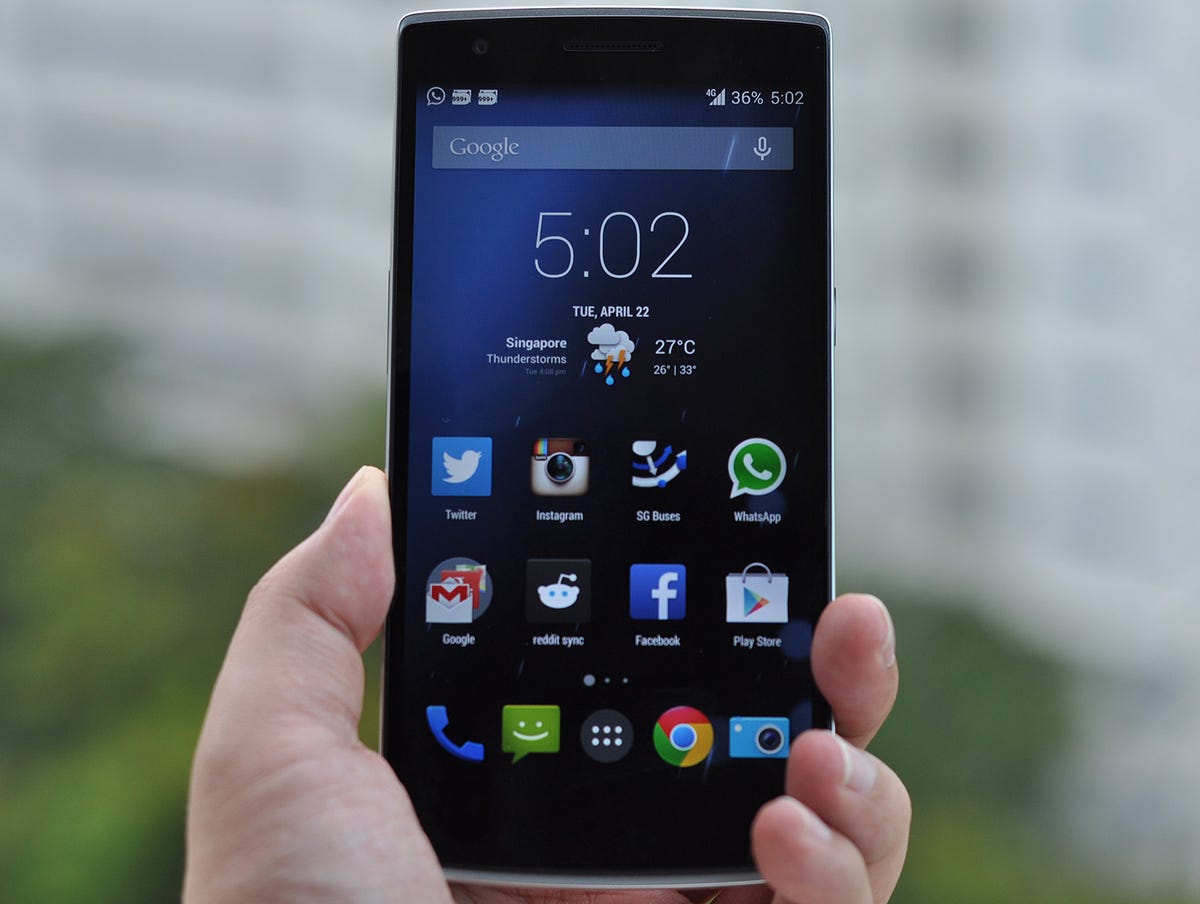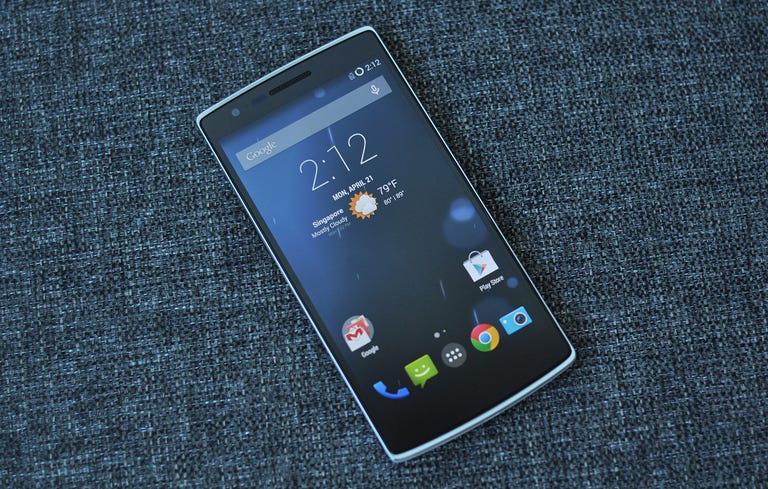 Why You Can Trust CNET
Why You Can Trust CNET OnePlus One review: A high-end smartphone for Android experts
Sporting specs comparable with current flagship smartphones but selling at a much lower price, the 5.5-inch OnePlus One smartphone is a great deal -- if you can get one and know how to use it.
The OnePlus One has plenty of promise, and it doesn't disappoint. For a non-contract, SIM-free price of $299 (around £180 or AU$320) for the 16GB version and $349 (roughly £210 or AU$380) for the 64GB model, the Android-powered smartphone is one of the best deals you can get today. It's a terrific price for a 4G phone, especially if you don't need the fancy features found on the $700 HTC One M8 or the $600 Samsung Galaxy S5 .
The Good
The Bad
The Bottom Line
Yet there are some significant "buts" in this proposition. Getting your hands on a One is harder than you'd think. Ahead of a release that's set for sometime in June, OnePlus is selling the phone only via an odd invite system. Furthermore, you can buy it only on the OnePlus website, so you won't have the opportunity to get a test it in a shop. After-sale support is all online, too, which may be a problem given its rather unstable software. Furthermore, its 4G LTE works only on specific bands, meaning it may not function with your carrier.
All of these things make the One best for an experienced Android fan who wants as much freedom as the OS can bring -- and is willing to put in the effort to own it.
Still, in the highly competitive Chinese smartphone market, it could be that these low-cost marketing tactics will help OnePlus build awareness of its brand against heavyweights such as Xiaomi or Huawei. But at the end of day, it's the quality and performance of the One that will entice buyers, and fortunately, that's where this smartphone excels.
Design and specs
The design of the OnePlus One was instantly familiar, and after looking through my pictures of the Oppo Find 7 , it appears the phones are practically siblings -- only a few details such as the button layout and placement of the volume jack differ. That makes perfect sense, since OnePlus is part-owned by Oppo, and the One is made at Oppo's facilities.

The 5.5-inch, full-HD display, which has a resolution of 1,920x1,080 pixels, is bright and vibrant and is usable even under bright sunlight at noon. Weighing in at 160g, the handset felt light despite its size. That said, I found it a little too wide to use with one hand -- a 5-inch display is still my ideal size for one-handed operation.
Like the Find 7, the OnePlus One sports a slightly curved top and bottom. The power button is located on the right side, while the volume rockers are located on the left. When I tested an earlier prototype, the slim buttons were pretty hard to press. While the review unit's rockers are shorter in length, they're actually more clickable and easier to work with.
Instead of having the screen cover the entire front of the phone, the glass ends just slightly before the edges at the top and bottom. This exposes the silvery plastic below it, and I confess I'm not exactly fond of this design. It does catch the eye, but I have a feeling dirt is likely to accumulate at the edges, and it feels strange to touch, due to its having two edges instead of just one.
The OnePlus One has a soft-touch plastic rear, and it feels great. The curved edges mean nothing sharp digs into your palm when you're holding it, and the phone feels balanced and not the least bit unwieldy.
There are three touch-sensitive buttons located below the screen, but you can disable these and use onscreen keys if you prefer. When turned off, you can't see the buttons except under bright sunlight.
Unfortunately, you don't get a lot of exterior choices on the smartphone. The 3,100mAh battery isn't removable, and there's no micro-SD card slot located underneath. As such, you have to choose between getting the 16GB model or the 64GB version. With the more capacious model only $50 more (most phonemakers put a much bigger markup on extra storage), it's clearly the better deal.
The One is powered by a 2.5GHz quad-core Qualcomm Snapdragon 801 processor and a generous 3GB of RAM, putting in the top tier of mobile power. More on that in the Performance section, below.
4G LTE
It has LTE support for some US (AT&T and T-Mobile) and UK networks (EE and Three), as well as some in Europe -- but not all. This is potentially a major downside, especially as you can't try it out before paying for it. My advice would be to look at this list of 4G LTE networks, see which band your carrier uses, and compare it to this list of bands the One supports: 1, 3, 4, 7, 17, 38, and 40.
It's not as though it won't be able to make calls if it doesn't support your network's band, but you won't get the benefit of the fast data speeds you're paying for. Besides 4G, it has quad-band 3G, NFC, Bluetooth, and dual-band Wi-Fi.
Software and features
The OnePlus One runs modders' favorite CyanogenMod 11S, which is based on Android KitKat 4.4. It's very similar to stock Android, but with a few modifications. These include an expanded desktop mode, and the ability to use gestures to turn on the camera or the LED light when the display is turned off. Other interesting tweaks include a voice-activated wake-up, and themes that let you really customise how the UI looks.
Like the LG G2 and the HTC One M8, you can double-tap the screen to wake the OnePlus. This is quite cool, but you'll need to set up a passcode, or you could find your phone has been accidentally unlocked while it's in your pocket.
If you're thinking of switching from a Samsung or Apple smartphone, rest assured you won't feel lost, as the UI is very simple to use (similar to stock Android), and the tweaks you can access make the experience even better.
Unlike some phones from China, the OnePlus One comes with Google Play, and you'll find all the Google apps pre-installed, including Gmail and Maps.
My main gripe with the operating system is its lack of stability. During my time with the phone, I had to reboot it a few times to get it working properly and encountered a major bug with the OnePlus One's lockscreen, which made me unable to use the phone at all. The handset does get over-the-air updates, so these issues may be ironed out before long.
Camera
The OnePlus One comes with its own camera app, and it has a range of modes that can be easily activated by just swiping down or up on the screen. This isn't exactly obvious when you first use it, though -- I figured it out only when the camera activated and switched to a different filter while the phone was my pocket.
The 13-megapixel shooter uses a Sony Exmor IMX 214 sensor. The shutter is really fast, but image quality is average at best and depending on the lighting, you may end up with a very noisy picture with muddy details. There didn't seem to be any difference in quality with my review and the earlier prototype.
Performance
In the short time I spent with the OnePlus One, I was very impressed with its performance. This is in part because CyanogenMod is free of bloatware, but the OnePlus's hardware is the main reason.
In the Quadrant benchmark, the One scored 24,601, similar to the HTC One M8, while on the Linpack multithread test, the phone obtained a high result of 926.74 MFLOPs.
Call quality
While calls were generally clear with no distortion, I did have an issue with just how soft the audio volume is. I could barely hear the other party when I was in a noisy place, even with the volume set to the highest level. This is likely a software issue and can possibly be fixed in an OTA update. On the other hand, the dual stereo speakers were loud, and you'd be hard-pressed to miss notifications and alerts.
Battery life
As mentioned, the OnePlus One comes with an embedded 3,100mAh battery, which lasted me through a day of moderate use with about 30 percent left once I returned home from work. I set up two email accounts and had Facebook and Twitter on push. If you're a heavy user, you may want to keep a charger handy.
Conclusion
The OnePlus One is supposed to launch in the following 16 countries: Austria, Belgium, Denmark, Finland, France, Germany, Hong Kong, Italy, Netherlands, Portugal, Spain, Sweden, Taiwan, the UK, and the US. Availability is still restricted to those with invites for the moment. This means it's pretty hard to get your hands on one for now.
With a contract-free $299 (£180, AU$320) price for the 16GB model, there really isn't any phone out there that's as cheap with the same top-end specs. The similarly-spec'ed Oppo Find 7a, for example, is $200 more at $499 (£295, AU$540), but it may be easier to obtain.
Given its blistering performance, the OnePlus One is a phenomenal deal for a high-end smartphone, as long as it's compatible with your network and you're happy to compromise on customer support and slightly sketchy software. It's not one for smartphone novices or the faint-hearted, but it's still a cracking bargain nonetheless.


